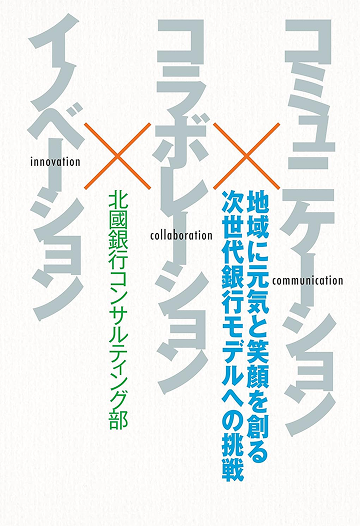Book Details
Communication, Collaboration and Innovation
-

- This translation has been generated using AI.This book presents the trajectory of over 20 years of organisational reform at Hokkoku Bank, along with its evolving role as a regional leader. Rather than simply describing systems and policies, it illustrates the bank’s transformation through hands-on initiatives, challenges, and lessons learned—highlighting how it continues to grow alongside its community.
- Published in 2017
Chapter 1: Customer-Centric Management and Organisational Reform
As the bank moved forward with reforms such as abolishing sales quotas and consolidating branches, it placed strong emphasis on changing employee mindsets. For example, rather than simply reducing paper usage, it began with cultural reform—ensuring that electronic approvals were preceded by meaningful discussion and consensus. The goal was not just efficiency, but improving the quality of communication.
In designing its new headquarters, the bank adopted a transparent layout with glass-walled executive offices, allowing visibility from the secretarial area. This architectural choice symbolised a commitment to openness and helped foster a more communicative organisational culture. These changes were not just about physical space—they were designed to reshape how people think and behave at work.
Chapter 2: Talent Development and External Expertise
The bank launched a strategic management project in collaboration with a global consulting firm—an unusual move for a regional financial institution. Despite internal resistance, such as “What could outsiders possibly know about our region?”, the bank embraced external perspectives to fundamentally reassess its operations.
As part of the project, employees participated in workshops to review their own workflows and propose improvements. For instance, inefficient practices around executive scheduling and reporting were identified and replaced with real-time communication tools like Slack and Teams. These improvements were driven from the ground up by frontline staff.
Chapter 3: Realising a Cashless Society and Supporting the Region
The bank developed and distributed “Green POS,” a tablet-based point-of-sale system using iPads, small printers, and cash drawers to create a simple yet powerful retail solution. Integrated with card payments, it enabled automatic sales tracking and inventory management.
Visa debit cards were actively promoted, including family and corporate options. In places like Suzu City shopping centres, even elderly customers embraced contactless payments. The bank also introduced point reward schemes and promotional campaigns, creating a win-win ecosystem for merchants, users, and the bank itself.
Chapter 4: Cloud Banking and Enhanced Security
Using cloud-based AI, the bank built a system to automatically detect anomalies in customer behaviour and usage environments. This enabled rapid response to potential fraud in internet banking, balancing security with convenience.
In developing its cloud banking platform, the bank adopted agile methods rather than traditional waterfall approaches. Despite initial clashes in development culture with its partners, mutual understanding led to a highly rated service that was both user-friendly and visually intuitive. Cloud migration also brought significant cost savings and flexibility, with plans to expand services to corporate clients.
Chapter 5: Supporting Overseas Expansion and Acting as a Regional Trading Company
To support local businesses in entering overseas markets, the bank opened a Singapore branch. This was not just a physical presence—it included trade fairs, buyer matching, and seminars on export regulations and pricing.
For example, companies dealing in traditional crafts were encouraged to use “experiential exhibitions,” which led to active negotiations and nine confirmed deals, with twelve more in progress. Local staff provided ongoing support, overcoming language and distance barriers. Even during the pandemic, the bank adapted by introducing online meetings and digital exhibitions. These efforts positioned the bank as more than a financial institution—it became a regional trading partner.
Chapter 6: Supporting Businesses Across Their Lifecycle
In helping a manufacturing firm recover, the bank conducted one-on-one interviews with 100 employees over the course of a month. Recognising the emotional toll of downsizing, it prioritised rebuilding trust, believing that “if employees lose faith, bankruptcy is inevitable.”
In another case, a retail company faced challenges such as paper-based sales logs, Excel-based scheduling, and poor communication. Through direct engagement with the CEO, the bank launched a company-wide project to improve efficiency and productivity, addressing issues department by department.
Chapter 7: ICT Integration and Operational Reform
ICT support began not with tools, but with a fundamental rethink of meetings and communication. When asked to improve internal communication, the bank dug deeper into organisational structure and decision-making authority, ultimately offering strategic HR reform rather than just groupware deployment.
In hospital management, the bank proposed leasing medical equipment to avoid interest rate competition and diversify funding. By combining ICT-driven efficiency with faster decision-making, it helped reduce frontline burdens while improving financial health.
